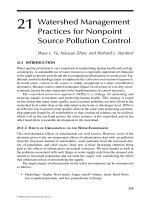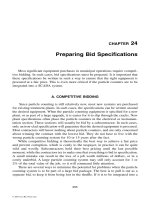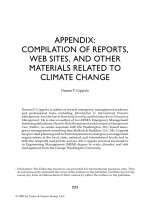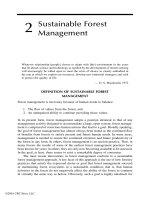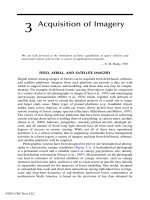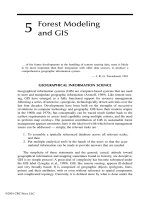GIS for Coastal Zone Management - Chapter 21 (end) pps
Bạn đang xem bản rút gọn của tài liệu. Xem và tải ngay bản đầy đủ của tài liệu tại đây (625.63 KB, 19 trang )
CHAPTER TWENTY-ONE
Environment Canada’s Atlantic Sensitivity
Mapping Program
André Laflamme, Stéphane R. Leblanc, and Roger J. Percy
21.1 INTRODUCTION
Canada’s Atlantic Region along with other regions across the country have
focused on providing consistent and standardized applications related to coastal
mapping and data integration/generation during a drill or spill incident. This
consistency is crucial if personnel are to be brought in from different regions, as
they are immediately familiar with the process and terminology. In an effort to
protect the environment and mitigate potential impacts, Environment Canada’s
Atlantic Sensitivity Mapping Program (ASMP) was designed to provide this level
of support to environmental responders. The ASMP has become a very powerful
tool providing a consistent terminology through the entire range of pre-spill
planning, preparedness, and real-time response activities.
This paper will describe the scope, objectives, and current status of this
mapping initiative and highlight recent developments in combining the full range
of activities from data generation and decision development to the generation of
sensitivity mapping. The desktop mapping application provides an easy-to-use
approach to the manipulation, display and output of a wide range of technical and
supporting data and information stored in various databases. In the development
of its mapping program, Environment Canada relied on crucial partnerships with
organizations willing to share data and expertise. Response managers and
environmental responders now have access to sensitive resource information that
normally would be difficult to collate and present in a map form under the
pressures of a spill response.
The objective of developing and maintaining the best possible sensitivity
mapping system is to provide planners and managers with the full range of
information they require as part of pre-spill activities as well as resource protection
recommendations at the time of a spill. The data and information are based on
consistent sets of terms and definitions that describe the shore-zone character, the
objectives and strategies for a specific response, and the methods by which those
© 2005 by CRC Press LLC
objectives may be achieved. These data are linked with other resource information
in a GIS based system.
Standard or accepted terms, definitions, and shoreline segmentation
procedures are already in place for describing the shore-zone character and shore-
zone oiling conditions. In this program, a set of standardized objectives and
strategy statements have been developed that can be entered easily into a database;
these provide a better level of consistency than do phrases or sentences constructed
by different recorders or evaluators. The suggested protection and treatment
objectives and strategies are intended for consideration by the spill response
management team. The actual type and volume of spilled oil, plus local
environmental conditions and local priorities would be brought to bear on the
decision process at the time of a spill. The suggested objectives and strategies
provide a starting point and a framework for decision makers and planning and
operations managers to discuss objectives and priorities. The concept of
management by objectives provides a framework for decision-makers to set the
goals of an operation at both the regional and a segment-by-segment level (Percy,
LeBlanc, Owens, 1997).
The pre-spill database is integrated with the actual Sensitivity Mapping
Program which is capable of displaying natural, cultural and man-made features
vulnerable to oil spills. The computerized mapping system facilitates quick access
and management of multiple data sets. A user-friendly interface allows queries
and statistical analysis of data and display of graphical outputs. The system
provides a tool for both planning and response; information can be accessed or
modified using a laptop computer and real-time spill information or trajectory
model outputs can be incorporated.
21.2 PARTNERSHIP
Following the Exxon Valdez spill in Alaska, the government of Canada realized
the need for a system to provide access to sensitivity data for planning and
response purposes. The Green Plan provided initial funding to develop, create and
maintain a sensitivity mapping system to support environmental responders during
marine spill incidents. Environment Canada was tasked to lead this project and
was assigned the responsibility to gather and manage appropriate data sets from
various agencies. Because of its mandate, Environment Canada has environmental
emergency officers on duty on a 24/7 basis. Therefore, information must be
quickly accessible in order to mitigate a potential impact on marine and coastal
resources.
Without ready access to environmental data, the integrity of coastal and
marine resources can be compromised during a spill incident if immediate action is
not taken to protect them. Partnerships are crucial in order for environmental
emergency responders to locate and identify sensitive resources at a spill site,
especially within the first few hours/days of an incident. One of Environment
Canada’s foci is to approach and involve other federal, provincial, municipal
agencies, private industry, local communities, etc. to make environmental data
accessible. Most of the organizations involved during a spill incident are part of
the Regional Environmental Emergencies Team know as REET.
© 2005 by CRC Press LLC
REET has two main operating roles: planning and response. As part of the
planning function, "team" members meet once a year to exchange scientific and
technical information on such matters as contingency planning and spill response
techniques. During this time, REET members also update and review their
respective roles in any emergency response. In its response role, REET operates
as a team of experts, advising the On-Scene-Commander, or OSC, in emergency
situations. Chaired by Environment Canada, it is composed of scientific advisors,
private contractors, community groups, etc.
21.3 GEOGRAPHIC APPLICATION
The coastal area covered by the Atlantic Region Sensitivity Mapping Program
encompasses four provinces: these are New Brunswick, Nova Scotia, Prince
Edward Island, and Newfoundland/Labrador. Approximately 12,500 unique
shoreline segments covering more than 40,000 kilometres of coastline have been
identified in Atlantic Canada. Labrador is the only area not presently covered by
the shoreline classification; however growing interests and activities in this area
will likely require the completion of the pre-spill database in the near future.
Portions of the province of Quebec have been included in the mapping system:
these are Chaleur Bay (on the north shore of the St. Lawrence River) and the
Magdalene Islands, since these areas would likely be impacted by spills in the
Atlantic Region. Despite the coastal applications of the mapping system, it also
has the flexibility to cover the inland part of the Atlantic Provinces.
Environmental data has been collected for the Maine and New Brunswick border.
The Atlantic Region Sensitivity Mapping Program in conjunction with the Maine
Department of Environmental Protection have agreed to exchange cross border
information on coastal areas which can be used for planning and response during
marine incidents that could impact both countries. As the information becomes
available for inland areas, the mapping system will integrate the information in a
format that is compatible with the existing data sets. Most of this information
comes from federal, provincial, and municipal government, as well as local
knowledge.
21.4 SHORELINE CLASSIFICATION AND PRE-SPILL DATABASE
The objective of the pre-spill database is to collate data and information that would
be required and used by the spill response management team in the development of
planning, priority and operations decisions. This database plays a fundamental
role in the definition of resource protection priorities, and constitutes an
introduction to the Shoreline Clean-up and Assessment Techniques (SCAT)
process.
The database development procedure involves an initial segmentation of the
shoreline followed by the creation of data templates for each segment. This
process involves the use of various tools such as low-altitude videotape survey
data, aerial photography, and pre-existing mapping materials to define sections of
shoreline that have a uniform along-shore character. In Atlantic Canada, each
segment has a unique two-letter prefix code followed by a sequential number
© 2005 by CRC Press LLC
(Figure 21.1). The two-letter prefix is unique to one coastal area in Atlantic
Canada which makes each code different (e.g.: Halifax Harbour has the following
segment codes: HX-01 to HX-75).
Figure 21.1 An example of the shoreline segmentation of the Northwest Arm area near Halifax, NS.
The description of the shore zone and the development of appropriate
response strategies are presented in a systematic format based on four distinct
templates: shore zone character, shoreline protection, shoreline treatment, and
summary of response and requirements.
These templates contain a total of 143 different attributes which are unique
for each shoreline segment. The Shore Zone Character template describes
information such as shoreline material/type, nearshore environment, longshore
current, oil traps and potential behaviour, resources at risk, etc. (Owens & Dewis,
1995). The shoreline material/type is further subdivided into five distinct
categories: lower inter-tidal material, lower inter-tidal form, shoreline type (area
located between the high and low tide mark), backshore material, and backshore
form (Table 21.1)
The Shoreline Protection and Treatment/Cleanup Templates offer a variety of
shoreline data including treatment and protection methods, objectives, strategies,
and operational considerations. The last template is known as the Summary of
Response Requirements. It is a summary of the protection and treatment templates
and includes a response priority code (L = low, M = medium, H = high, VH = very
high). The response priority code is defined based on the information available at
the time of collection of the pre-spill database. Although it is a starting point in
defining priorities, Environment Canada’s Sensitivity Mapping Program is now in
the process of incorporating other data sets in order to define a response priority
© 2005 by CRC Press LLC
code which will better reflect the actual resource inventory for a specific shoreline
segment.
Table 21.1 Shoreline material/type found in Atlantic Canada
Lower ITZ Material Lower ITZ Form Backshore Form
anthropogenic concrete anthropomorphic breakwater anthropomorphic breakwater
anthropogenic wood anthropomorphic pier/jetty anthropomorphic bridge
anthropogenic riprap anthropomorphic pilings anthropomorphic causeway
bedrock resistant anthropomorphic seawall anthropomorphic road
bedrock unresistant anthropomorphic bridge anthropomorphic dyke
boulder anthropomorphic wharf anthropomorphic pier/jetty
cobble beach anthropomorphic wharf
mixed coarse with sand cliff anthropomorphic railway
marsh grass dune anthropomorphic seawall
Mud platform barrier beach
pebble salt marsh beach
Sand tidal flat cliff
delta dune
Backshore Material low-islets flat
anthropogenic asphalt peat bog
anthropogenic concrete Shoreline Type platform
anthropogenic riprap bedrock salt marsh
anthropogenic wood boulder beach spit
bedrock resistant man-made solid wetland bog
bedrock unresistant mixed sand-gravel beach delta
mixed coarse with sand mud tidal flat
mixed coarse-no sand pebble-cobble beach
marsh grass salt marsh
peat sand beach
sand sand tidal flat
These templates use a knowledge-based concept, as data and
recommendations are entered, in part, from knowledge and experience rather than
from an objective analysis. The templates are described in detail by Owens and
Dewis (1995). The shoreline protection and treatment or cleanup techniques that
are recommended for each segment are derived from the Environment Canada
Field Guide for the Protection and Cleanup of Oiled Shorelines (Owens, 1996).
The description of the physical character of the shore zone for each segment
is broken down into the lower intertidal zone, the upper intertidal zone (which
corresponds to the nine accepted standard shoreline types (Figure 21.2)) and
backshore coastal character.
The shoreline type is a description of that area of the shore zone where oil is
most likely to be stranded and the coastal character is described since this is the
area in which backshore operations will stage and deploy resources. The
description also includes identification of features that are likely to affect the
behaviour of persistent oil, such as alongshore traps, potential boulder or riprap
© 2005 by CRC Press LLC
reservoirs, etc. Figure 21.3 gives an example of the Shore Zone Character
template for a specific shoreline segment in the Atlantic Region.
Figure 21.2 Nine standard shoreline types used to describe shore character.
Other areas outside Canada where the same shoreline classification approach
has been applied include Hawaii (Honolulu-Waikiki), Russia (Sakhalin Island) and
Alaska (Port Valdez). A number of countries around the world have shown
interests in the Atlantic Region Sensitivity Mapping Program, including
Bangladesh, Brazil, Spain, Israel, Chile, and France.
© 2005 by CRC Press LLC
Figure 21.3 The shore zone character template is one of the four available in the pre-spill database.
More than 143 attributes are available for each shoreline segment.
© 2005 by CRC Press LLC
21.5 SENSITIVITY MAPPING SYSTEM
All computerized mapping systems require base map layers. Over the past years,
Environment Canada purchased National Topographic Data Base (NTDB) digital
maps from Natural Resources Canada - Centre for Topographic Information in
Sherbrooke (Quebec). Three different scale were purchased: 1:50,000, 1:250,000
and 1:1,000,000. All three scales are used to represent specific information
according to whether large- or small-scale maps are required. Once the base maps
were visualised to reflect as much as possible the symbols and colours of the hard-
copy versions, the digital maps were grouped to form one big region (Figure 21.4).
Figure 21.4 Atlantic Canada Sensitivity Mapping Sub-Regions (not shown are: Labrador).
The shoreline classification and the pre-spill database constitute the most
important components in the mapping system. The classification describes the
physical aspects of the shoreline and provides useful information on protection and
clean-up methods. In addition, the mapping system allows for the display of
various databases such as birds, fish, shellfish, aquaculture sites, parks,
archaeological sites, etc. (Table 21.2). With all this information available, the
mapping system can provide a detailed report for any given area.
The user has the option of defining a buffer zone which can be used to
determine the sensitive resources within an area; to calculate features such as
length of shoreline or area affected; or to display data in a graphical form (Figure
21.5). This last example contains shoreline lengths within a polygon for shoreline
type, backshore type, biological resources, and human use resources. The
information can be displayed in the form of bar graphs or pie charts, and a detailed
report on the affected resources may also be generated. The report contains
© 2005 by CRC Press LLC
information on various species or human-use resources, their sensitivity to oil
spills and their seasonal vulnerability. A complete database of photographs related
to sensitive birds, fish, shellfish, vegetation, and human use structures such as
aerial photographs of small craft harbour can also be displayed. In addition to the
Natural Resources digital base maps, the system can also display information from
digital hydrographic charts or digital elevation models (Figure 21.6).
Table 21.2 Type of information and source (* - Available only during real incidents)
Database Source
Pre-spill database (MS Access) Environment Canada
Shoreline Classification Environment Canada
1:50,000 NTDB maps Natural Resources Canada
1:250,000 NTDB maps Natural Resources Canada
Logistical/Operational Data Response Organization
Fish Fisheries & Oceans Canada
Shellfish Fisheries & Oceans Canada
Mammal Fisheries & Oceans Canada
Amphibian/Reptile Fisheries & Oceans Canada
Vegetation Fisheries & Oceans Canada
Small Craft Harbour Fisheries & Oceans Canada
Whale Sanctuary Fisheries & Oceans Canada
Fish Weir & Trap Fisheries & Oceans Canada
Bird Canadian Wildlife Services
National Wildlife Area Natural Resources Canada
Wildlife Conservation Area Natural Resources Canada
Ecological Reserve Canadian Wildlife Services
Bird Sanctuary Canadian Wildlife Services
Seabird Colony Canadian Wildlife Services
Aquaculture Site Provincial Government
Archaeological Site Provincial / Federal Government
*
Recreational Beach Provincial Government
Provincial Park Provincial Government
Municipal Park Municipal Government
Sewage Outfall Municipal Government
Water Intake Municipal Government
Historic Site Heritage Canada
Sewage Treatment Plant Municipal Government
Recreational Fishing Municipal Government
Salmon River Provincial Government
Fish Processing Plant Municipal Government
Hydrographic Chart Canadian Hydrographic Services
Federal Properties Treasury Boards Canada
National Historic Site Heritage Canada
Federal Park Heritage Canada
Aerial Shoreline Video Geological Survey of Canada
Digital Elevation Model Natural Resources Canada
Offshore Rigs Location Environment Canada
Pulp & Paper Mills Environment Canada
© 2005 by CRC Press LLC
© 2005 by CRC Press LLC
Figure 21.5 a,b,c One of the strengths of the mapping system is the ability to define a buffer
zone and extract resource information within that area. The program can generate reports in
text and graphical form.
Figure 21.6 Hydrographic chart and digital elevation model used as base layers.
© 2005 by CRC Press LLC
21.6 SUMMARY
The Atlantic Region Sensitivity Mapping Program’s main focus is to provide a
consistent and standardized application across jurisdictions. This consistency is
crucial if personnel are to be brought in from different regions during a drill or
spill, as they are instantly familiar with the process and terminology. The same
sets of standard terms and conditions are applied to pre-spill database
development, sensitivity and pre-spill mapping, SCAT data generation, and the
response management decision process. Although the use of standard terms and
definitions is almost essential for the description of oiled shorelines, the value of
standardization extends into the decision process with regard to shoreline
protection and treatment recommendations. This concept is very powerful as it
provides a consistent terminology through the entire range of pre-spill planning
and response activities.
Sensitivity mapping often has been viewed as an isolated activity in spill
planning. Although the identification of resources at risk is a study that can stand
alone, the application of that information into the response decision process
involves a broader perspective. The integrated approach for spill response in
Canada uses sensitivity information as one part of a larger body of relevant
information that can and should be used by the decision team in the formulation of
an appropriate response. For example, the pre-spill database includes information
for each shoreline segment that describes potential oil traps or oil behaviour
considerations, possible operational constraints, as well as the resources that are at
risk.
The desktop mapping package provides an inexpensive and easy-to-use
approach to data management and manipulation. The data can be updated quickly
and easily with new information as this becomes available, or during a spill
incident, and this new information can be presented immediately in map form.
The Atlantic Region Sensitivity Mapping Program keeps evolving to better
serve the needs of environmental responders. All components described in this
document will soon be integrated in a web-mapping format which will offer the
same features and functionality as the stand alone version. The main advantage of
designing a web mapping application resides in its broader accessibility and ease
of use. Future developments include the completion of the pre-spill database for
Labrador.
21.7 REFERENCES
Owens, E.H., 1996a,
Field Guide for the protection and cleanup of oiled
shorelines
, 2
nd
Edition (Dartmouth: Environment Canada), pp. 201.
Owens, E.H., 1996b, The management of shoreline protection and treatment
operation. In
Proceedings 19
th
Arctic and Marine Oil Spill Programme (AMOP)
Technical Seminar
(Edmonton: Environment Canada).
Owens, E.H. and Dewis, W.S., 1995, A pre-spill shoreline protection and shoreline
treatment data base for Atlantic Canada. In
Proceedings 18
th
Arctic and Marine
Oil Spill Programme (AMOP) Technical Seminar
(Edmonton: Environment
Canada).
© 2005 by CRC Press LLC
Percy, R.J., Leblanc, R.S. and Owens, E.H., 1997, An integrated approach to
shoreline mapping for spill response planning in Canada. In
Proceedings 20
th
Arctic and Marine Oil Spill Programme (AMOP) Technical Seminar
(Edmonton:
Environment Canada).
© 2005 by CRC Press LLC
Epilogue: Meeting the Needs of Integrated
Coastal Zone Management
Jennifer L. Smith and Darius J. Bartlett
The emergence of Integrated Coastal Zone Management (ICZM) represents a
paradigm shift for a range of practitioners who work in the complex, dynamic area
where land meets sea. The structure and implementation of geomatics
technologies has been strongly affected by this shift, and GIS/RS practitioners
have stepped up to meet the information needs of ICZM by creating coastal
information systems featuring increased rigour, openness, and useability.
As a result of this forcing, coastal GIS/RS is increasingly differentiating
itself from the marine sciences and emerging as a unique discipline. In 1999,
Wright wrote: “it may be fair to say that marine applications of GIS have been
more in the realm of basic science whereas coastal applications, due in part to the
intensity of human activities, have encompassed both basic and applied science, as
well as policy and management.” This move towards an integrated approach is
being realized in parallel with similar shifts in the approach of other actors in the
coastal zone, including scientists, managers and planners. The principles of
Integrated Coastal Zone Management make explicit what coastal GIS/RS
practitioners have known for years: that the coastal zone is a uniquely complex
system that requires new and innovative management approaches.
Here we outline the nature of this paradigm shift and the ways in which the
authors in this volume have tackled the challenges of applying GIS to the
integrated management of the coastal zone.
The principles of Integrated Coastal Zone Management
A thorough discussion of the inception and principles of Integrated Coastal Zone
Management can be found in Cicin-Sain (1993) and Cicin-Sain and Knecht
(1998). The following draws heavily upon these sources.
ICZM has been described as a process for decision-making: it should be
continuous, iterative, and should recognize the contributions of stakeholders and
the natural dynamism, both physical and ecological, of the coastal environment.
A primary goal of ICZM is to overcome the compartmentalized approach to
managing coastal resources by harmonizing the decisions of diverse jurisdictions
and levels of government. In particular ICZM aims to bridge the traditional divide
between management of the land and of the water. ICZM, therefore, is also about
building institutions that facilitate this integration.
ICZM is founded on principles of sustainable development, recognizing that
the coastline is the fount of resources of great value to human communities and
© 2005 by CRC Press LLC
that these resources should be managed in ways that conserve their value for future
generations. In addition to the extractive resources (such as fishing, hunting,
aggregate extraction, and harvesting of algae), ICZM aims to recognize and
conserve those resources that provide ecosystem services, such as seagrass beds
that provide nursery habitat and mangroves that act as a defense against storm
surge and erosion.
The outcome of these principles is a planning methodology that employs an
ecosystem approach to management (considering interconnected elements of the
ecosystem) and incorporates adaptive management to deal with uncertainty,
variability, and change.
The role of GIS/RS in ICZM
The principle function of geomatics technologies in the coastal milieu has
traditionally been that of a tool for converting data into information, which is in
turn either published as basic science or fed into the balance sheet of the rational
decision-making process. With the emergence of ICZM, however, the role of
GIS/RS has evolved. In response to the ICZM imperative, coastal geographic
information systems are increasingly integrative of scientific and socioeconomic
elements, increasingly dynamic, temporal and predictive, and are often the tool
that effectively brings stakeholders together.
GIS is often defined as a synergy of hardware, software, data, and people
(ESRI 1990). Clearly, the changing role of the technology is accompanied by a
changing role for the people who build and operate coastal information systems.
This volume contains a diverse collection of chapters, all of which address
the application of GIS/RS and the role of its practitioners in the various facets of
an integrated approach to coastal zone management. The authors in this book have
begun the process of finding solutions to the challenges presented by ICZM, and
are working towards these goals on several fronts.
Contributing to the capacity requirements of ICZM
Cicin-Sain and Knecht (1998) list four areas of critical capacity required for
ICZM. In defining “technical capacity” the authors make direct reference to the
role of coastal databases and information systems in gathering information on
coastal ecosystems and processes, on the patterns of human use that occur in the
coastal zone, and on the ongoing effectiveness of management activities. But
GIS/RS also has the potential to contribute to the other areas of required capacity
outlined by Cicin-Sain and Knecht: authors in this volume show how coastal
spatial databases can assist in the formulation, implementation and enforcement
elements of the
legal and administrative capacity required for ICZM. For example,
Both Pan and Lindsey
et al. outline the use of GIS to fulfil legistlative imperatives;
the TIS developed by Bourcier has the potential to provoke harmonisation of
diverse jurisdictions and regulatory regimes. Some authors have outlined their
contribution to the
human resources capacity of coastal management initiatives,
including bringing together multidisciplinary teams and fostering public awareness
of and involvement in coastal issues. To this end, Bartlett and Sudarshana examine
issues surrounding technology transfer; the standardised approach to risk mapping
© 2005 by CRC Press LLC
developed by Laflamme et al. facilitates transfer of workers from one Canadian
province to another in response to environmental emergencies; Nwilo describes
programs that have facilitated exchanges and training for coastal zone managers in
Africa; and many authors in this volume have found avenues for disseminating and
interpreting their work to interested stakeholders. And, although GIS are typically
expensive to implement, they can sometimes bring economies and recognition to
coastal management initiatives, thus enhancing the
financial capacity of the
project in the long-term. Initiatives for advancing geomatics in the coastal zone,
like those of Webster
et al. and Nwilo, have attracted funding with spinoffs for
coastal communities.
Integrating data from diverse sources
If the worth of a GIS is determined by how faithfully it represents the real world,
creating a servicable GIS is challenging indeed when data of sufficient resolution,
coverage and quality are difficult to acquire and unite for reasons of protectionism,
conflict and variable format or standards. The ICZM imperative of integration
across jurisdictions and institutions makes this issue doubly significant in the
coastal zone. Authors in this volume, along with virtually every other coastal GIS
practitioner, face this challenge daily and are working to find strategies that yield
information systems that meet the needs of ICZM. Bourcier, Laflamme
et al. and
Mosbech
et al., among many others in this book, have addressed the challenge of
collecting and harmonizing data within a distributed, fractured, multi-agency and
multi-jurisdictional region (the Seine estuary, the Eastern Canadian coastal zone
and the Greenlandic coastal zone, respectively). Gomm considers issues specific
to data integration across the land-sea divide, and Gourmelon writes about the
process of coordinating a large number of institutions in the creation of a large-
scale GIS.
Sometimes the greatest challenge to harmonising datasets is finding them.
Longhorn describes the development of Coastal Spatial Data Infrastructures
which, at their best, facilitate the formulation of standards, the sharing of data, and,
ultimately, a more collaborative, open and connected network of coastal GIS
applications.
Even in areas where standards and data-sharing protocols are in force, the
increasingly rich and diverse database of many coastal regions leaves to GIS
practitioners the task of determining the best available representation of coastal
phenomena, as in Li
et al., who compared different data sources to arrive at the
most accurate depiction of the coastline or Hwang and Ku, who outlined methods
for choosing remotely sensed data at a resolution that best meets the needs of a
coastal modelling excercise.
The work of all of these authors shows that geography can provide the scale
and scope that is needed to unite diverse interest groups. Issues of data integration
appear to be casting GIS developers as a uniting force and GIS as a nexus in the
project of ICZM.
© 2005 by CRC Press LLC
Adapting tools and technologies to serve the stakeholders of ICZM
We are now faced with the task of expressing the methods and results of what was,
until recently, a specialized and technical discipline to a diverse group of scientists,
managers, regulators, legislators, resource users and members of the public. These
people are increasingly not just data
consumers but also data users, who both
demand and deserve to peer inside the black box of GIS technology and GIS-based
decision support. GIS practitioners in this volume have responded by creating
innovative visualisations, interfaces and forums for participation in the course of
applying GIS to the coastal zone.
Involving stakeholders in both the formulation and the output of coastal GIS
goes beyond the technical and presents intercultural and interpretive challenges.
Bartlett and Sudarshana touch on the pervasiveness of Western metaphors in
coastal GIS and the need to consider the cultural background of the stakeholders or
collaborators. On Alaska’s Pribilof Islands, Lindsay
et al. collaborated across
jurisdictions and cultures to construct a GIS that represents archeological features,
important traditional resources, local placenames and the legacy of destructive
industries. In another Arctic environment, Mosbech
et al. gathered traditional
knowledge to create an oil spill sensitivity database that considers resources of
importance to local people. Both of these projects required that the researchers
constructing the GIS consider the needs, concerns, and sensitivities of those people
who will ultimately be affected by decisions based upon the outcomes of the
exercise. Jude describes an exercise in visualizing the outcome of a coastal
development: he applies GIS and RS in a way that makes the effects of change real
and explicit to a non-technical audience.
Broad new user groups are now working directly with the data and software
that has traditionally been the domain of experts. The Internet has excercised its
all-pervasive influence here: Laflamme
et al., Green and King and Macharia
describe web applications that bring GIS to a broader audience when and where
information is needed. Longhorn discusses Coastal Spatial Data Infrastructures,
that aid in making data accessible to a greater cross-section of users and in
supporting the wider popularization of desktop GIS. Planning for consultation,
infrastructures and dissemination is now seen as a critical phase in any coastal GIS
initiative, and coastal GIS practitioners must keep the needs of stakeholders and
future users in mind.
Improving tools and technologies
Because the land-sea interface is a complex ecotone, the scale of biophysically
distinct areas in the coastal zone often necessitates a spatial resolution that has
traditionally been difficult or expensive to acquire. GIS/RS practitioners working
in the coastal zone were until recently either limited to a few data sources (such as
analogue photogrammetry or bathymetric and topographic mapping by traditional
survey and sounding means), or required to adapt the scale and resolution of their
work to the quality of readily available remotely sensed data, i.e. satellite data at a
30m or greater resolution, often with poor depth penetration, particularly for turbid
temperate waters. The challenge of acquiring high-quality data has been
somewhat ameliorated by the increasing availability of quick-deploying
hyperspectral sensors like CASI (Compact Airborne Spectrographic Imager) and
© 2005 by CRC Press LLC
active laser sensors like LiDAR (Light Detection and Ranging) or active satellite
sensors with specialised uses in the marine environment (such as RadarSat). Both
Pan and Webster document their experiences and the technical challenges they
faced in acquiring and applying data from these sensors, and both authors make
explicit the great advances possible with such high (spatial and/or spectral)
resolution data. Of particular importance to ICZM is the value of these fast-
deploying sensors for monitoring change and perhaps even emergencies in the
dynamic and heterogeneous coastal zone. High resolution data is one more piece
in the puzzle of building rigorous, accurate and precise models of coastal zone
processes.
Adapting the technology to represent complex dynamic systems
Tracking and analyzing spatio-temporal variation is a problem that has received
much attention from geographers and GIS practitioners. In the coastal zone, it is
compounded by the other challenges described here. Practitioners are faced with
the need to deal with (and differentiate between) error and dynamism in an
inherently dynamic environment. Bruce provides a detailed outline of the types of
error and uncertainty encountered in coastal zone GIS and the various methods
that have been developed to help practitioners quantify and work with this
uncertainty. Li
et al. describe methods for defining ‘the coastline’ in such a way
that the variability of this elusive entity is accounted for. Schupp
et al. have
measured historical shoreline change in order to learn about future change.
Webster
et al. describe how dynamic coastal processes at different time scales
(extreme tidal range, seasonal variability, and sea level rise) entered into the
decisions that were made in the process of acquiring high resolution imagery and
elevation data in a coastal area, then uses these data to plan for future changes. If
change is the currency of ICZM, then developing data structures and modes of
analysis that integrate dynamism into coastal GIS is critical.
Modelling for decision support
Applying GIS/RS in ICZM presents the challenge of using new technology in a
real-life context, where models and findings are fed into a legislative and
regulatory application and are subjected to not only academic but also
governmental, public and vested private sector scrutiny. Coastal GIS practitioners
have acknowledged the need to continue to make their models more robust at the
same time as they become more complex and comprehensive. Populus
et al. and
Mayerle and Toro, for example, both undertook to model complex hydrodynamic
processes with the explicit goal of using these models for decision support. Euan-
Avila
et al. considered land-based activities and their socio-economic drivers in
modeling effects on water quality.
© 2005 by CRC Press LLC
Conclusions
Researchers and practitioners are increasingly taking an interdisciplinary,
integrative approach to applying GIS/RS in the coastal zone. As the body of work
in this area grows, so too does our understanding of coastal processes and the role
of humans in perturbing and managing these systems. GIS has much to contribute
to Integrated Coastal Management, and GIS practitioners have many more
challenges to face in constructing truly integrative coastal spatial information
systems.
REFERENCES
Cicin-Sain, B., 1993, Sustainable development and integrated coastal management.
Ocean & Coastal Management, 21 (1-3), pp.11-43.
Cicin-Sain, B. and Knecht, R. 1998,
Integrated Coastal and Ocean Management:
Concepts and Practices,
(Washington and California: Island Press).
ESRI, 1990,
Understanding GIS: The ARC/INFO Method, (Redlands, CA:
Environmental Systems Research Institute).
Wright, D. J., 2000, Down to the Sea in Ships: The Emergence of Marine GIS. In
Marine and Coastal Geographic Information Systems, edited by D.J. Bartlett and
D. J.Wright, (London: Taylor and Francis).
© 2005 by CRC Press LLC

